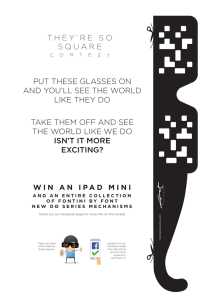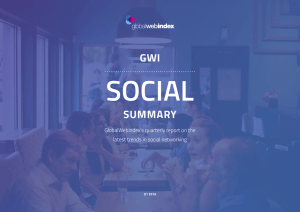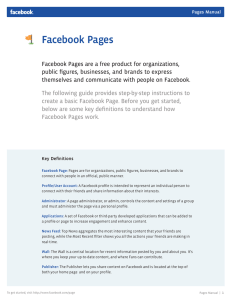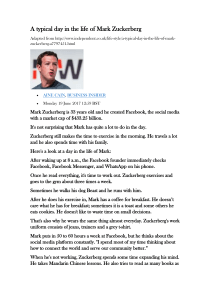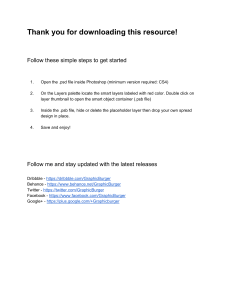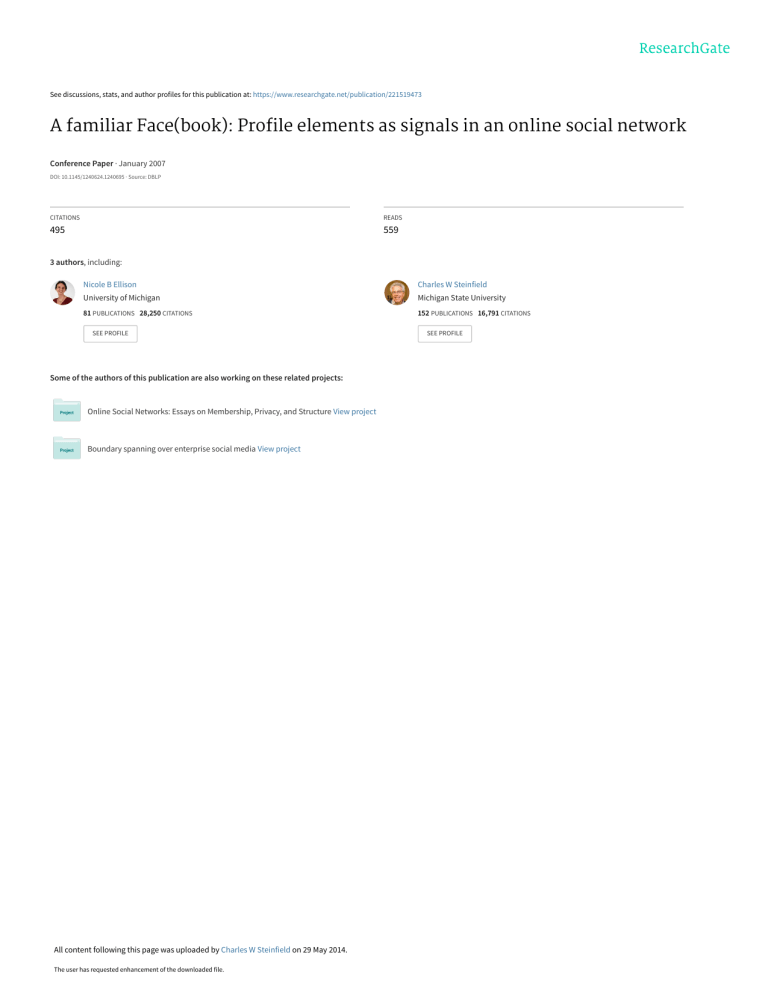
See discussions, stats, and author profiles for this publication at: https://www.researchgate.net/publication/221519473 A familiar Face(book): Profile elements as signals in an online social network Conference Paper · January 2007 DOI: 10.1145/1240624.1240695 · Source: DBLP CITATIONS READS 495 559 3 authors, including: Nicole B Ellison Charles W Steinfield University of Michigan Michigan State University 81 PUBLICATIONS 28,250 CITATIONS 152 PUBLICATIONS 16,791 CITATIONS SEE PROFILE Some of the authors of this publication are also working on these related projects: Online Social Networks: Essays on Membership, Privacy, and Structure View project Boundary spanning over enterprise social media View project All content following this page was uploaded by Charles W Steinfield on 29 May 2014. The user has requested enhancement of the downloaded file. SEE PROFILE DRAFT Manuscript: Submitted to CHI 2007 – September, 2006. Not for Circulation. A Familiar Face(book): Profile Elements as Signals in an Online Social Network Cliff Lampe, Nicole Ellison, and Charles Steinfield Dept. of Telecommunication, Information Studies, and Media Michigan State University, East Lansing, MI ABSTRACT Using data from a popular online social network site, this paper explores the relationship between profile structure (namely, which fields are completed) and number of friends, giving designers insight into the importance of the profile and how it works to encourage connections and articulated relationships between users. We describe a theoretical framework that draws on aspects of signaling theory, common ground theory, and transaction costs theory to generate an understanding of why certain profile fields may be more predictive of friendship articulation on the site. Using a dataset consisting of 30,773 Facebook profiles, we determine which profile elements are most likely to predict friendship links and discuss the theoretical and design implications of our findings. Author Keywords social network sites, profile elements, signaling theory, ACM Classification Keywords H5.m. Information interfaces and presentation (e.g., HCI): Miscellaneous. INTRODUCTION User profiles are an integral part of social network sites and can include a vast array of user-contributed content. However, little is known about the specific effects user profiles have on interactions in online communities. Intuitively, we believe that profiles can help create a sense of presence and must garner positive outcomes for their users given the time commitment they require to complete and keep updated; yet we do not know what types of included information matter. This gap in understanding motivates our basic research question: how do elements in a profile influence the outcomes from using an online social network? Online communities have different goals, but a common and important enterprise is forming connections between users. This is especially true for online communities that focus on articulating social networks, such as Facebook, MySpace, Friendster and Orkut, where the number of friends a user lists may act as a simple proxy for their connectedness in the network. Connections between users in an online community may be important for facilitating other tasks of the group [14][17], reducing misbehavior [7] [15], and building types of social capital [10,16], [28] among other potential benefits. To examine the role of profile elements in the formation of online connections, we focus on Facebook.com, an online social network site. Facebook, as with similar sites like MySpace and Friendster, allows users to create in-depth profiles describing themselves, and then to establish explicit links with other users, who are described as “friends” by the system. Facebook is a particularly appropriate site to study as it has profile creation and network articulation as primary community tasks, meaning that there is a consistency of action across the different users that allows for variance to be more clearly articulated and examined. Also, although Facebook is now open to those without academic affiliations, at the time data were collected, Facebook communities generally corresponded to existing offline network membership, typically related to academic environments like universities. This offline connection has several implications. First, it allows the establishment of a natural boundary around the network that assists when determining who is a member and who is not. Second, the connection to an offline network might increase the likelihood of profile use by offline contacts, as the chances that a relationship formed in the online environment will extend to an offline meeting. This means that profile information has more opportunities to be verified than in other online communities. Third, participation may be reinforced by offline connections, contributing to a take-up rate for a given population that may be higher than normal. As mentioned above, Facebook is divided into networks based on affiliation with a particular offline institution. Consequently, users from University A are not, by default, considered part of the network of University B. Our study focused on one network within Facebook, namely the network defined by membership in X State University (XSU). Membership in a university network is defined by Facebook as having a valid email address assigned by that university. 1 DRAFT Manuscript: Submitted to CHI 2007 – September, 2006. Not for Circulation. In this paper, we report on an empirical study of the XSU Facebook community. Specifically, using data collected from all accessible XSU Facebook members via an automated script, we explore how profile elements relates to the number of friendship connections among users. The paper is organized as follows. We first review related literature, focusing on theoretical explanations for why profile information may influence online social network activity. The next section outlines the methodological approach for an empirical test of research questions generated by our review. We then present results, highlighting the explanatory power of selected profile elements. The paper closes with a discussion of the implications of our findings, as well as study limitations and overall conclusions. Literature Review In this section, we explore prior work that establishes the basis for our primary proposition: That the amount and type of information included in user profiles should affect the number of articulated relationships in the online community. Individuals form impressions of others in order to decide whether to pursue or continue a relationship [19]. In initial impression formation, individuals form impressions very quickly -- in as little as three minutes in face-to-face settings [20]. In order to achieve relational and other goals, individuals attempt to manage these impressions, strategically emphasizing some characteristics while deemphasizing others [11]. These same self-presentational behaviors exist online, although online self-presentation is more malleable and subject to self-censorship than face-toface self-presentation due to the asynchronous nature of computer-mediated communication (CMC) and the fact that CMC emphasizes verbal and linguistic cues over less controllable nonverbal communication cues [23]. These same processes of impression formation and management take place in online settings, albeit slightly differently due to the affordances and constraints of CMC. In online environments, traditional identity cues, such as accent and style of dress, are not available. Early research assumed this forced online interactants to operate in a vacuum of identity cues, with attendant negative consequences for interpersonal relationship and community formation [5] [17]. However, subsequent work developed a more optimistic assessment (for review, see [27]), noting that CMC groups just needed more communication time than face-to-face groups, in order to compensate for CMC’s slower rate of exchange [24]. Walther’s Social Information Processing theory posits that online users compensate for the lack of traditional cues in online environments by looking towards other kinds of cues, such as spelling ability [21] [26][25]. Evidence for SIP has been generated in other contexts such as MUDs [22] and online dating [10]. Online interactants seeking to form impressions of their communication partners must assess not only the content of 2 the identity claims made by others, but also the veracity of these claims. As Donath [8] writes, “In order for a signal to have its intended effect, the receiver must both understand and believe it.” Although deception in offline environments is common [6], the ability to selectively self-present online [23] means that some kinds of misrepresentation (e.g., “gender-bending”) are more easily accomplished via CMC. In some online environments such as online dating, misrepresentation is a significant concern [10]. Users in online environments rely on a variety of cues to make determinations about one another; however, all these cues are not deemed equally credible. For instance, Goffman [11] notes that identity cues can be intentionally given or unintentionally given off, and that we are more likely to privilege those cues that are perceived to be unintentional as opposed to strategically constructed. This ability to engage in deceptive self-presentation online is compounded when interactants do not share a social network and therefore have less access to “information triangles” such as mutual friends who might confirm or deny information [2]. Theoretical motivations We draw upon three theories to help explain how profile construction might affect participation in online communities. Signaling theory addresses the type of information that can be placed in profiles, suggesting that profile elements act as signals that may prove something about the identity of the user. These signals can be manipulated by senders to communicate personal qualities, or interpreted by receivers to make judgments about the characteristics of other users. We use common ground theory to explain the motivation of filling out profiles, which is to establish common frames of reference that enhance mutual understanding. Transaction cost theory bridges the two former theories and suggests that certain profile elements may facilitate the production of shared referents, which usually involves costly negotiations between participants, and makes it easier for interactants to engage in other forms of communication (such as email). Signaling and the verifiability of profile entries Signaling theory addresses a basic question: what keeps signals reliable in contexts where deception can be beneficial [8]? Based on work in biology [30, 31], Donath argues that a signaling system must evolve so that it is beneficial for participants to produce reliable signals, but costly to produce deceptive ones. Building on contemporary signaling theory, she distinguishes between many different kinds of signals, including those that reliably indicate possession of some quality simply through observation of the signal, which are termed assessment signals, and those that only indicate a quality through social convention, which are termed conventional signals. As she notes, lifting a heavy weight is an assessment signal that reliably indicates that a person is strong. Wearing a Golds® Gym T-shirt is a conventional signal that suggests that the person works out and therefore is likely to be in shape, but is easy enough to acquire that the wearer might actually be weak. DRAFT Manuscript: Submitted to CHI 2007 – September, 2006. Not for Circulation. However, as easily seen from these examples, conventional signals are cheaper to produce and more prone to deception. Donath points out that online contexts generally only support conventional signals – people construct their profiles with words or images that are easily manipulated – and therefore the question of how and why signals in online profiles are reliable is relevant. membership communities in order to ensure the success of their definite references. Common membership is used in this case to interpret which references can be made and understood without overtly explaining the meaning of the reference. An American, for example, could reference “Bush” and expect another member of that community to understand they mean President Bush. Signaling theory provides clues as to why Facebook profiles might be more "honest" than profiles found in other online fora. Donath and boyd [9] argue that a shared social network can provide explicit or implicit verification of identity claims. Therefore, the structure of Facebook should encourage more truthful profiles, or misrepresentations that are playful or ironic as opposed to intentional deceitful. The transparency of friendship networks, the likelihood of an offline meeting, and the connection to offline community that can easily verify claims, all suggest that in general, despite the fact that online profiles contain conventional signals, they are easy to police and therefore deception can be costly. There are different types of elements that can be signaled in a Facebook profile - some more verifiable, and hence more easily tied to the ability to police their honesty, than others. Such elements might include those that place a member in a particular physical locale (e.g. their high school and home town, their location on campus), a particular community or group on the campus (e.g. their major and their classes) or other verifiable personal and physical attributes (e.g. their relationship status and gender). Assuming that people will be more likely to articulate a relationship with (or, in Facebook lexicon, to “friend”) those who include these verifiable identity cues (such as high school) in their profile, we thus expect that the more these elements are included, the more “successful” one will be in the Facebook context, using size of friendship network as a proxy for success. Hence, we propose that inclusion of these elements will have an impact on number of friends, and their presence may enhance the signaling value of other aspects of the profile that are less verifiable (e.g. interests). This type of common ground is important in interactions because it facilitates understanding and fosters cooperation between participants, especially in cases where group members are not well-known to each other or are interacting through information and communications technology [4, 13]. Establishing common ground in online communities Common ground theory tells us why the inclusion of more information in the profile in general should lead to greater numbers of friends. Including locational information (hometown, etc.) establishes common ground, and interests reveal personality aspects that can help people make decisions about declaring friendship links. Clark [3] describes community membership as an important characteristic to consider when trying to assess the amount of shared understanding that already exists between participants. Membership in different communities will involve generic and particular knowledge that can be used as common frames of reference to build common ground. . As Clark states, “the trick is to judge community membership, and there are many ways to do that” (pg. 37). As people interact, they attempt to find common Profile elements provide clues about fellow participants in an online community that may act like the subtle interviewing done in face-to-face environments to find shared communities of membership or common ground [9]. Participants of Facebook may see someone is in their concentration of study, which indicates that the person will understand a range of references that a person in another field may not. If one sees another profile listing a shared hometown, they might expect the person to understand references to landmarks and events in that area. Having listed a particular movie as a favorite indicates the person will understand references to dialogue or scenes in that movie. Facebook enhances the ability of these profile elements to define membership communities by linking terms in a way similar to tagging. Consequently, listing “Citizen Kane” as a favorite movie would create a link by which one can search for all other users in the network who have listed the same movie. Reducing the cost of connection The signals that can be included in user profiles help reduce the cost of finding the common referents that lead to increased understanding between participants. In the economic literature, transaction costs are costs incurred in the process of economic exchange, and can explain why it is that certain types of markets fail [29]. They include costs of search (e.g. for products, trading partners, price discovery, etc.), negotiation (e.g. legal and contracting costs), settlement (e.g. fees for currency exchange and costs to transport products), and monitoring (e.g. product inspection and other means to verify that terms are being met). If transaction costs are too high, exchange may not occur. In this case theorists suggest that firms internalize production, substituting generalized labor contracts – often termed hierarchy – for specific market contracts. Electronic transactions over the Internet – or e-commerce – are often considered to have reduced transaction costs, enabling markets to function where hierarchy might have prevailed otherwise [1]. Key to this is the effect on search costs. The Internet makes it easy to locate alternative suppliers of a desired good or service, especially when few vendors are present in a local market. 3 DRAFT Manuscript: Submitted to CHI 2007 – September, 2006. Not for Circulation. Just as in economic exchanges, search costs can easily influence the likelihood that a connection will be made in an online social network. Profiles make it easier to find others who have matching interests or other desired attributes. Indeed, matchmaking sites that help users find romantic partners can easily be analyzed from a transaction costs theory perspective, using such concepts from the theory as search costs, opportunism, and asymmetric information. In the case of an online social network site like Facebook, the ability to search profiles reduces the costs associated with finding former high school classmates, people in the same concentration or major, or people in the same dormitory, even without a potential partner's name. The more profile elements there are, the more refined, and hence accurate, a search can be. Thus, profiles reduce search costs, and therefore reduce the costs of making connections. Hence, from a simple transaction costs theory point of view, we should expect that the more profile elements a person has, the more likely others will find him or her, and thus make connections. Transaction cost theory might also explain why some types of profile elements may be more important than others, mainly when the connection is being made with a new acquaintance. In this case, elements that are more like the "assessment" signals noted above (which are potentially verifiable), might be considered as helping protect against opportunistic behavior. In an online social network, opportunism can be used to describe when a person lies in order to make him or herself more attractive to another person. Profile elements that are less reliable are more difficult to monitor. Hence, a transaction cost theory perspective would suggest that these verifiable elements would have more of an impact on the likelihood of making a connection than other elements. Moreover, some profile fields explicitly provide contact information, making it easier to follow-up on a search. These further reduce the costs of making connections. Hence, we would expect that both verifiable elements and contact elements would have a stronger effect on the number of friends than profile elements that only provide preference information. Research Questions This review highlights a number of ways in which profile entries may be associated with online social network users’ articulated friendship networks. We next present the methods used to enable us to explore several research questions suggested by this review, including: 1. What are the relationships between the various types of profile entries and the number of friends a user has on their social network site? 2. Are some types of profile entries more strongly associated with the number of friends listed? 4 METHODS For an initial analysis of the use of profiles in online communities, we used automated scripts to measure the use of fields in Facebook profiles and associate those with the number of links between participants. This section will describe that process, and discuss how we code profile elements into different types of signals. Data collection As mentioned above, Facebook is divided into networks defined by membership in offline institutions, and this study focuses on the network defined by membership in X State University. It is not well known how networks within Facebook may differ from each other, but the XSU Facebook seems broadly comparable to descriptions of Facebook networks at other academic institutions [12, 18]. Data were collected from the XSU Facebook site using automated scripts that downloaded information in profile fields and saved that information in offsite databases. The data reported here were collected between April 1 and April 13 2006, which was the amount of time necessary to collect info from every user on the site. Privacy settings could be set by users that would prevent the script from reading a profile. This occurred in 7,634 cases, or 19% of the profiles, leaving us with 30,773 usable profiles. This is a problem for analysis in that these users are consequently excluded, and may have characteristics that make them different from the population of users who do not elevate their privacy settings. There are several potential issues with this data collection method besides the loss of individuals with high privacy settings. For example, this data collection method is fragile to changes made by the Facebook design team. Over its brief history, Facebook has added and removed fields, changed data entry points and altered interface options. This means that not every user profile on Facebook is going to have the same data. Similarly, many of the profile fields on Facebook are optional which means that for some users fields will be empty. Independent Variables In this analysis, the independent variables being studied are the various fields of the Facebook profile. We measured whether available fields had been populated by each user, and in some cases how much information had been added to the field. We divide the profile elements into four categories: control variables, location variables, preference variables, and contact variables. For the referents, preference and contact variables we created indices by summing across the variables based on whether fields in those categories were used (coded as 1) or not (coded as 0). We then standardized the indices to make them comparable. Tables at the end of each section summarize these variables and describe their categories. DRAFT Manuscript: Submitted to CHI 2007 – September, 2006. Not for Circulation. Control variables In our analyses we tracked two variables that have been shown in social network literature to affect network characteristics: sex of the member and length of membership in the network. Of the XSU Facebook users, 93.8% listed their sex with 53% listed as females. The age of account is a field that was automatically displayed at the time of data collection. To these characteristics, we added a third descriptive variable likely to have an effect on participation, namely institutional status. As Facebook is largely oriented to academic populations, one would expect different participation from sub-populations within those institutions. To wit, being an undergraduate is likely to create a different Facebook experience than being faculty.Finally, we added to the set of control variables the “Last Updated” field, which is an automatically displayed profile element indicating when the user last made any change to their profile. Since we did not have measures of user activity like page views or number of times the profile is updated, the last updated field acts as a very rough measure of account activity. Accounts that have not been updated in months signal something different than accounts updated within the past week. Table 1 displays the profile fields included in these measures and the percentage of users populating these fields. At the time of data collection, these fields were typically auto-filled, so have high participation rates. Field Description % Hometown Town of residence before joining MSU 83.3% High School School attended before college 87.1% Residence Specifically addresses on-campus housing 45.1% Concentration Major field of study 89.5% Table 2: Fields included in the referents index, and percentage of users populating that field. open-ended “About Me” field are interpreted as conventional signals, by which the user is crafting an image of themselves for other users. These signals are easy to produce, though harder to verify. Still, these profile elements may be used to judge similarity between the profile consumer and the profile producer. For example, shared movie favorites might indicate similarity between participants, with anticipation of agreement along other axes. Table 3 displays the profile fields included in this Field Description % About Me Open-ended field allowing users to describe themselves 59.8% Interests Items separated by commas become linked, enabling search for other users listing same. 77.7% Field Description % Sex Gender of the user. 93.8% Status Type of institutional member 100.0% Member Since Auto field listing account creation date 100.0% Favorite Music Same as above 78.2% Last Updated Auto field listing last profile update time 100.0% Favorite Movies Same as above 80.1% Favorite TV Shows Same as above 46.5% Favorite Books Same as above 66.9% Favorite Quotes Content not linked. 73.8% Political Views Drop down list of political spectrum options 60.9% Table 1: Fields included as control variables, and percentage of users populating that field. Referents Index The first index of variables was based on fields related to common points of reference among users. Listing shared past referents allows the profile creator and user to find common ground, and share narratives. Users who list the same high school, even if they didn’t attend it together, could make references to shared traditions, teachers or physical locations. Table 2 lists the profile fields included in this referents index, and the percentage of users who populate those fields. Interests Index A second index was created based on the use of profile fields that express personal preferences and self-descriptive information. Favorite movies and music, activities and an Table 3: Fields included in the interests index, and percentage of users populating that field. index, and the percentage of users who populate that field. Contact index A third index contained profile fields whose presence seemed to indicate a willingness to share off-site connections with the user. Users populated a variety of fields that would allow the user to be contacted via other media, ranging from email to specific offline location 5 DRAFT Manuscript: Submitted to CHI 2007 – September, 2006. Not for Circulation. information. Birthday is included, since birthday notices are broadcast to a user’s friend list. Table 4 shows the profile fields included in the contact index, and the percentage of users who populate these fields. Field Description % Relationship Status Drop down list of relationship states 78.5% Looking for Check button list of types of relationships sought 50.8% Website Allows for multiple web addresses to be input 29.1% Address Current address – non campus 13.5% Drop downs to select day/month/year 83.8% AIM AOL Instant Messenger screen name 67.8% Email Default is the user’s school email, which is also used to join the site 92.3% Birthday conventional, and contact. We used the log of the number of friends as a dependent measure in the regression analysis, because the friend distribution was highly skewed with a long tail created by smaller numbers of users with extremely large numbers of friends. We further standardized all of the non-nominal variables in order to deal with unequal scale ranges. We report the statistical significance of the results, even though our sample more closely resembles a census of the XSU Facebook community, and with this sample size nearly all differences would be “significant.” However, we can conceptualize this group of users as a sample of the entire Facebook community, and so use the relative differences in estimate strengths to guide interpretation. RESULTS Table 4: Fields included in the contact index, and percentage of users populating that field. Dependent Variables Our primary dependent measure is the total number of “friends” a user has on Facebook. Facebook allows for two types of “friendship” links: with users at the same institution or with users at other institutions (now called "networks"). Our script tallied this information using the number of friends listed in each user’s profile. Table 5 reports on the mean and median number of both friend links, as well as the standard deviation of the mean. In addition to friendship links, we report the average ratio of friend links from the same school over all friendship links. This gives a rough measure of the proportion of the user network that exists at the same institution. Mean Std. Dev Median Same School 95 86 75 Other School 84 78 68 Ratio 0.53 0.18 0.53 Table 5: Friendship links for XSU Facebook members Profile use Facebook users participate widely in the fields that allow them to present themselves to other users. On average, users fill 59% of the fields available to them, and in some fields display a significant amount of information. Tables 1-4 show whether individual profile fields are used, but does not show anything about how much information is added when the fields are open-ended. The categories “About Me,” “Interests,” and “Favorites” are the most open fields available to Facebook users, with users able to articulate many preferences that shape the public persona they are trying to present to others. Table 6 shows the average and median number of items in each of these fields, except in the “About Me” field for which the average and median number of characters is reported. We report the median value as it is the measure of central tendency more resistant to the presence of strong outliers, which is the case for this dataset. Profile field Average items Median items Interests 6.5 5 Favorite Book 2.5 1 Favorite Movies 6.5 5 Favorite Music 8.8 3 Favorite TV Show 2.1 0 About Me* 157 36 Table 6: Median items in open-ended profile fields Analysis approach We explored the research questions by illustrating how the median number of friends differs based on different values in individual profile fields. We further used a multiple regression approach to see which clusters of profile elements were most strongly associated with the total number of friends. The main independent variables were the indices representing the theoretically derived groups of profile fields as described earlier – assessment, 6 “Friends” links As with other online social networks, Facebook has labeled declared relationships between members as “friends” links. Consequently, all members of the declared social network on Facebook are “friends”, whether a real friendship exists or not. XSU Facebook members are actively participating in the creation of friendship links. The number of friends at XSU vs those at different institutions is relatively stable DRAFT Manuscript: Submitted to CHI 2007 – September, 2006. Not for Circulation. across users, with a strong correlation between the number of different types of friends (Pearson r=.694). In the analyses below, we label friends also in the XSU Facebook network as “same institution” and those in different networks as “other institutions. User characteristics are related to number of friends As one might expect, the median number friends a user has will vary on demographic dimensions. Status in the institution, as shown in Table 7, is a particularly important factor associated with median number of friends both at the same institution and at different institutions. Same institution Other institutions Undergrad 87 83 Alumnus/Alumna 45 33 Grad Student 27 Faculty Staff practical differences when information is present vs. when it is not. Table 8 reports the five largest differences in number of friends at the same institution when that field is populated. One explanation for the importance of the High School, AIM and Birthday fields is that they help support the maintenance of pre-existing social networks that are being reified on Facebook. For example, a user might keep track of high school friends using the site. Favorite Music and About Me are slightly different in that they act as cues about the identity of the Facebook member, so are presumably targeted to users not in a pre-existing social network with the user. Same institution Other institutions yes no Yes no High School* 92 35 89 21 19 Favorite Music 83 37 75 33 29 8 AIM* 100 50 93 52 14 7 Birthday 80 26 73 21 About Me 88 56 78 52 Status Sex Female 80 76 Male 73 63 Table 7: User characteristics associated with differences in number of friendship links Undergraduate members have more friends than any other group in the network. Females have slightly more friends than do males. The older the account, the more friends of each type a user will have as well, with a Pearson correlation coefficient of r=0.37 between the age of the account and friends at the same institution, and a Pearson correlation coefficient of r=0.24 between the age of the account and friends at other institutions. Excepting cases of deception, these user characteristics are not controllable by the user as a means of signaling who they are. How are other profile elements associated with the number of friends a user has? Using profile fields is related to number of friends The act of populating profile fields is strongly associated with the number of friendship links a user will have. In Table 2 we showed which profile fields were available to users and what percentage of those users populate that field with information. In each case where that field is populated, users show a higher median number of friends. T-tests of those differences show significance on every dimension of p<.001, though the size of the dataset limits the usefulness of significance testing. Of more importance are the Profile Field Table 8: Five profile elements associated with the largest difference in number of friends. * Includes only undergraduate members Facebook changed a significant user interface element on March 23, 2006. Users who updated their profile on or after that date had 97 MSU friends compared to 49 for those who didn’t. Users who updated after the March 23 change had 88 friends at other institutions compared to 45 for those who didn’t. An interesting implication of this finding might be that as a social system like Facebook evolves, it will have an effect on the status of users based on their ability to keep up with site changes. The amount of information in profiles is weakly associated with number of friends It’s not just whether the information is present that is related to the number of friendship links, but how much information is presented. Table 9 reports the Pearson correlation coefficients between the number of items in open-ended profile fields and the number of friendship links held by the user. “Favorites” is a sum of all the entries in the five “favorites” fields. While not exceptionally strong correlations, these relationships between amount of self-descriptive content and number of friends have positive directionality. The nature of the directionality is unknown, but there is an association between how many items a person lists in their open-ended profile fields and the number of friendship links they have. There are many possible explanations for this, including people with many friends have increased social 7 DRAFT Manuscript: Submitted to CHI 2007 – September, 2006. Not for Circulation. Profile field(s) Same institution Other Institutions About Me r=.13 r=.13 Interests r=.21 r=.19 Favorites r=.14 r=.15 Table 9: Pearson correlations between number of items in profile and number of friends pressure to add information to their profiles, or that active users both add information to profile fields and seek out friends to link to. Multivariate analyses: factors predicting number of friends The previous univariate analyses indicate that individual profile elements are associated with differences in numbers of friends among Facebook users. In order to see which sets of profile entries have the strongest association, this section describes a regression analysis of profile element use and how much their use affects numbers of friends. Table 10 shows the results of an ordinary least squares regression (OLS) analyzing the effect these index variables, as well as select control variables, have on total number of friends listed by the user. Note that the adjusted R-squared value of 0.401 indicates this model explains around 40% of the variance in number of friends users have. Term Intercept Estimate t Ratio Prob>|t| -0.319 -14.71 <.001 Female 0.042 10.02 <.001 Alumni -0.045 -1.96 0.050 Faculty 0.027 0.40 0.688 Graduate -0.201 -7.82 <.001 Staff -0.230 -4.11 <.001 Member since -0.342 -78.62 0.000 Recency of last update 0.174 40.20 0.000 Referents Index 0.193 35.32 <.001 Interests Index 0.079 16.77 <.001 Contact Index 0.103 22.98 <.001 Adj. R-squared = .401 F=2061.10, P<.0001 N=30773 Table 10: Regression results predicting number of friends from provided profile information in the Facebook community The indices were entered into the model in a stepwise fashion, with each index increasing the explanatory power of the model. The dependent measure for this model is the log of the number of friends, used to reduce the effects of variance between users. Variables that included the amount of information in About Me, Interests and Favorites were 8 also added, but did not have an effect on the model, so are excluded in Table 10. This is significant in that it doesn’t appear to matter how much information is included in profile fields, just that some information is included. The results demonstrate that profile field use has a very strong association with the number of friends a user has on Facebook. As we would expect, undergraduates have more friends on the system than others, as do those who have been members for a longer period of time. The recency with which users had updated their profiles contributed to the explanatory power of the regression. Regarding the three indices, the referents index had the largest coefficient, followed by the contact index and then the interests index. The fields in the referents index are harder to falsify than information in the interests field. In this way, the referents may be acting more similarly to assessment signals as described by Donath [8]. Referent profile fields may also be acting as mechanisms to ease search costs, reduce transaction costs, in enabling latent ties from offline networks into the Facebook social network. That is to say, a user may not be searching for people who like Citizen Kane to add to their friends list, but they may be seeking out users who went to their high school. DISCUSSION We found that populating profile fields on Facebook is positively related to the number of friends a user will have listed. The amount of information posted in open-ended fields does not affect the number of friends when added to the indices of the presence of information in the profile fields. Even after controlling for gender, time on the system, user status in the community, and the recency of updating, significant variation in the number of friends is associated with the supply of other types of profile information. Information that helps share common referents – same high school or home town, same major, same classes – should be important. From a common ground point of view, it provides an immediate establishment of common referents that can foster interaction. From a transaction cost point of view, it reduces the costs of search for potentially relevant contacts. Ellison et al [10] suggest that Facebook may be helping to make connections out of “latent” ties by supplying this information. Preference information also contributed to the explained variance in number of friends, but showed the weakest association of our three indices. These conventional signals may be used more in a playful and ironic sense, and may not necessarily be relied upon as strongly to gauge similarity for finding new connections. Theoretical Implications This paper draws upon three theoretical threads to create a framework that elucidates the relationship between self- DRAFT Manuscript: Submitted to CHI 2007 – September, 2006. Not for Circulation. presentation, as measured by fields in a user profile, and relationship articulation as measured by “friend lists”, using data gathered from a popular online social network site, Facebook. To date, this relationship has not been explored in a way that draws upon behavioral data and theory. Signaling theory can help explain why Facebook differs from other online contexts, due to the shared social network that can help warrant identity claims [9]. Common ground theory is used to explain how users can find areas of shared connection and share narratives. Finally, transaction cost theory sheds light on how these sites may make it easier for individuals to find others they want to connect with, as it makes visible commonalities and allows participants almost effortless ways to locate and communicate with others. .Our synthesis of signaling theory, common ground theory, and transaction cost theory suggested that in an online social network that is constructed around an existing offline community, certain types of profile information might be particularly important. One theoretical contribution of this approach is that it highlights the underlying shared thrust of each of these theories – namely, that they are concerned with how to reduce the costs associated with interaction. Common ground theory speaks to making interactions more efficient through assumptions about shared referents. Transaction costs approaches examine the ways in which interactions, such as finding “friends,” can be made more efficient through these systems. Finally, signaling theory enables us to direct our resources towards those who we believe are representing themselves accurately. Design Implications Online communities depend on many-to-many interactions between participants with heterogeneous goals, backgrounds and characteristics. The often constrained media of online interactions make it difficult to develop a sense of fellow participants in online communities. These findings indicate several possible design implications for fostering these interactions. Given that common referents was a strong indicator of number of friends, additional search features could be added to online communities to create these connections. Allowing people to search by shared city, institution or job type may create a sense of connection that facilitates interactions. Another implication is on the choice of fields included in user profiles. While common referents were important in this case, other communities may find that personal preference fields matter more than in the Facebook case. The design guideline derived from these data is to include fields that can be used to highlight similarities between users. Limitations This study looks at one particular online community, Facebook, and sub-section of that site devoted to members of X State University. In addition, the study looks at profile use at a particular moment in time, and since data collection Facebook has changed many of the fields used in profiles. While generalizing these results to all online communities should be discouraged, we do feel that the basic insight that profile elements can act as signals to facilitate social browsing stands as a general contribution. Facebook is tied to offline interactions in a way few other online communities are. It could be that offline friends create social pressure to use certain profile fields, which would also be translated as online social ties. This means that the causal direction could well be in either direction – something our data is not able to sort out. The data we collected are gathered from data users place on the Facebook site, which has the benefit of being behavioral but the deficit of not addressing attitudes or motivations at all. This work cannot address either how users perceive profile elements, or how they feel their profile elements will be received by others. Additionally, many of the profile elements included in the regression model are recorded in the binary through our data collection. While univariate analysis seems to indicate the amount of information in profile fiends isn’t important, the content of the fields may very well be. Both of these limitations need to be redressed in future research, particularly through interviews with users. CONCLUSION User profiles in online communities can play a role in the functioning of the site. This paper describes how users of Facebook populate fields, and that different profile elements have different consequences for the number of friends listed on the site. Profile fields that help users share common referents are more highly associated with numbers of friends that fields that share personal likes and dislikes. Online communities may be able to use profiles strategically to foster their goals. Profile development, such as happens on Facebook, allows users to present themselves to their fellow community members, and get a sense of those with whom they are interacting. Further study in user profiles can help us understand both how we make sense of one another online, but also how to improve that sense of each other for more productive interactions. ACKNOWLEDGMENTS We would like to thank Facebook for permission to use automatic scripts on the XSU site. We also thank (obscured) for help in setting up the scripts used to collect data. REFERENCES 1. Bakos, J. (1999) Reducing Buyer Search Costs: Implications for Electronic Marketplaces. Management Science, 43 (12). 1676-1692. 2. Berger, C.R. Planning and scheming: Strategies for initiating relationships. in Burnett, R., McGhee, P. and Clark, D. eds. Accounting for relationships: 9 DRAFT Manuscript: Submitted to CHI 2007 – September, 2006. Not for Circulation. Explanation, representaion and knowledge, Methuen, New York, 1987, 158-174. 3. Clark, H.H. Arenas of Language Use. University of Chicago Press, Chicago, IL, 1992. 4. Clark, H.H. and Brennan, S.E. Grounding in communication. in Resnick, L.B., Levine, J.M. and Teasley, S.D. eds. Perspectives on socially shared cognition, APA Press, Washington, 1991. 5. Culnan, M.J. and Markus, M.L. Information technologies. in Jablin, F.M., Putnam, L.L., Roberts, K.H. and Porter, L.W. eds. Handbook of organizational communication: An interdisciplinary perspective, Sage Publications, Thousand Oaks, 1987, 420-443. 18.Stutzman, F., An Evaluation of Identity-Sharing Behavior in Social Network Communities. in iDMAa and IMS Code Conference, (Oxford, OH, 2005). 19.Sunnafrank, M. (1986) Predicted outcome value during initial interactions: A reformulation of uncertainty reduction theory. Human Communication Research, 13. 3-33. 20.Sunnafrank, M. and Ramirez, A. (2004) At first sight: Persistant relational effects of get-acquainted conversations. Journal of Social and Personal Relationships, 21 (3). 361-379. 6. DePaulo, B., Kashy, D., Kirkendol, S., Wyer, M. and Epstein, J. (1996) Lying in everyday life. Journal of Personality and Social Psychology, 70 (5). 979-995. 21.Tidwell, L.C. and Walther, J.B. (2002) Computermediated communication effects on disclosure, impressions, and interpersonal evaluations: Getting to know one another a bit at a time. Human Communication Research, 28 (317-348). 7. Donath, J.S. Identity and Deception in the Virtual Community. in Kollock, P. and Smith, M. eds. Communities in Cyberspace, Routledge, London, 1998. 22.Utz, S. (2000) Social Information Processing in MUDs:The Development of Friendships in Virtual Worlds. Journal of Online Behavior, 1 (1). 8. Donath, J.S. Signals, Cues and Meaning, unpublished. 23.Walther, J.B. (1996) Computer-mediated communication: Impersonal, interpersonal, and hyperpersonal interactions. Communication Research, 23. 1-43. 9. Donath, J.S. and boyd, d. (2004) Public displays of connection. BT Technology Journal, 22 (4). 71. 10.Ellison, N., Heino, R. and Gibbs, J. (2006) Managing Impressions Online: Self-Presentation Processes in the Online Dating Environment. Journal of ComputerMediated Communication, 11 (2). 24.Walther, J.B. (1993) Impression development in computer-mediated interaction. Western Journal of Communication, 57. 381-398. 11.Goffman, E. The Presentation of Self in Everyday Life. Doubleday, New York, NY, 1959. 25.Walther, J.B. (1992) Interpersonal effects in computermediated communication: A relational perspective. Communication Research, 19. 52-90. 12.Gross, R. and Acquisti, A., Information Revelation and Privacy in Online Social Networks. in Workshop on Privacy in the Electronic Society, (Alexandria, VA, 2005), ACM Press. 26.Walther, J.B., Anderson, J.F. and Park, D.W. (1994) Interpersonal Effects in Computer-Mediated Interaction. Communication Research, 21 (4). 460-487. 13.Olson, G.M. and Olson, J.S. Distance matters. in Carroll, J. ed. HCI in the New Millennium, AddisonWeasley, New York, 2001. 14.Preece, J. and Maloney-Krichmar. Online Communities. in Jacko, J. and Sears, A. eds. Handbook of HumanComputer Interaction, Lawrence Erlbaum Associates Inc., Mahwah, NJ, 2003, 596-620. 15.Reid, E. Hierarchy and power: Social control in cyberspace. in Smith, M.A. and Kollock, P. eds. Communities in Cyberspace, Routledge, London, 1999, 107-133. 16.Resnick, P. Beyond Bowling Together: SocioTechnical Capital. in Carroll, J. ed. HCI in the New Millenium, Addison-Wesley, 2001. 17.Sproull, L. and Kiesler, S. Connections: New ways of working in the networked organization. MIT Press, Cambridge, MA, 1991. 10 View publication stats 27.Walther, J.B. and Parks, M.R. Cues filtered out, cues filtered in: Computer-mediated communication and relationships. in Knapp, M.L. and Daly, J.A. eds. Handbook of interpersonal communication, Sage Publications, Thousand Oaks, CA, 2002, 529-563. 28.Wellman, B. (2001) Computer Networks as Social Networks. Science, 293 (14). 2031-2034. 29.Williamson, O.E. The Economic Institutions Capitalism. The Free Press, New York, 1985. of 30.Zahavi, A. (1975) Mate selection-a selection for a handicap. Journal of Theoretical Biology, 53 (1). 205214. 31.Zahavi, A. and Zahavi, A. The handicap principle. A missing piece of Darwin's puzzle. Oxford University Press, New York, NY, 1997.
